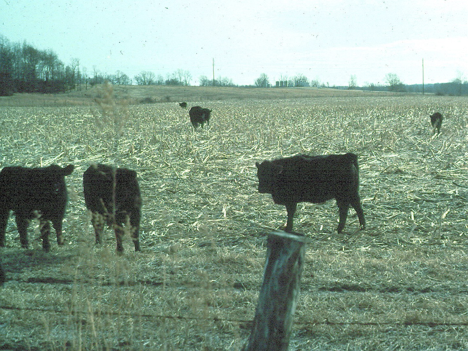
Grazing crop residues (especially after harvest of corn or grain sorghum) can routinely be used to provide a substantial number of days of grazing for beef cattle, but can be especially valuable in years when pasture and hay production have been less-than-optimum. This option becomes even more attractive if grassed waterways, terraces, and field borders are present within row crop fields.
Crop residues are an inexpensive feed source because most expenses are charged against the row crop enterprise. In a 4-year summary of experiments in Iowa, cows grazing corn crop residue at 2.5 acres/cow/season for 112 to 174 days required about one ton less hay per cow to maintain adequate body condition than cows maintained in a dry lot. Depending on stocking rate and length of the grazing period, beef cattle will normally consume between 30 and 40% of the crop residue when grazing corn stalks, leaving enough material to prevent soil erosion.
Livestock first select the portions of crop residues with the highest digestibility and protein concentration (Table 1), so supplement needs beyond trace mineral salt and vitamin A are likely to be minimal for the first month of grazing. Providing simultaneous access to stockpiled grass or late summer growth of legume forages may supply protein and energy, and also reduce the need for supplementation. As winter progresses and crop residue quality decreases because of grazing selection and weathering, supplementation of protein and phosphorus will likely become necessary.
Table 1. Relative amounts and values of corn residue plant parts
|
|
|
|
Plant |
Parts |
|
Item |
Husk |
Leaf |
Stem/a |
Cob |
|
Percent of residue dry matter |
12 |
27 |
49 |
12 |
|
Crude Protein, % DM |
3.6 |
7.8 |
4.5 |
2.2 |
|
In vitro dry matter disappearance, % |
67 |
47 |
45 |
35 |
|
Palatability |
High |
High |
Low |
Low |
a Includes leaf sheath
Wilson, C.B., G.E. Erickson, T.J. Klopfenstein, R.J. Rasby, D.C. Adams, and I.G. Rush. 2004. A Review of Corn Stalks Grazing on Animal Performance and Crop Yield, University of Nebraska 2004 Beef Research Report.
Strip grazing enhances efficiency of utilization, and helps ensure maintenance of a high quality diet for the animals over a longer period of time by reducing selective grazing. A caution associated with grazing corn crop residue is the potential of digestive problems associated with excessive grain consumption. Cattle may overload on spilled or dropped corn, thus causing founder (or acidosis) However, strip grazing reduces the likelihood of this disorder.
Also, a summer row crop such as corn that was heavily fertilized with nitrogen but subsequently received little rain, could contain potentially toxic levels of nitrates. Nitrate levels are highest in stem bases. Having a nitrate test run is inexpensive and should be done if there is any question about safety of a feedstuff.
Other points relative to grazing crop residues are as follows.
*Research conducted at several Midwestern universities shows no difference in the performance of cattle that grazed Bt corn crop residues and those that grazed non-Bt corn crop residues.
*Soybean stubble is low in quality and cannot alone provide adequate nutrition for beef cows or stockers. It should only be used a s a feed source if supplemented substantially.
*Before grazing crop residue fields, it is important to check the labels of any pesticides that were used on the crop. Label restrictions should be strictly observed.
*It is advisable to make certain no poisonous plants are present in fencerows or other areas adjacent to fields in which crop residues are to be grazed.
*As always, providing adequate quantities of clean water for livestock is essential.
Obviously, on many farms, grazing crop residues is not an option. However, on farms where row crops are grown or can be accessed via farmer-to-farmer agreements, this is a strategy that can be of much economic value.
_________________
Foraging Ahead is a column presented by Ragan & Massey and written by Dr. Don Ball, Professor Emeritus at Auburn University. Dr. Ball is one of the authors of the
